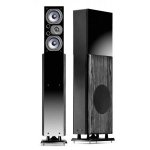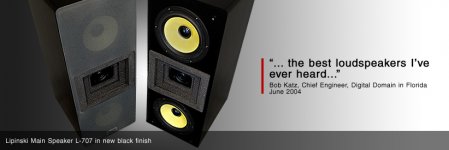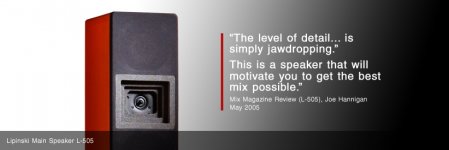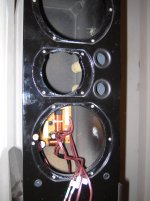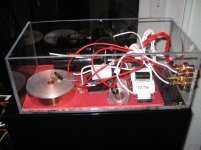Hi, this is my first post on this forum and I think I'll become a long time member since I've been wanting to get into this area as a hobby for a long time. Now I finally have some spare time to do so.
I have a project that I like to do which is to modify the Polk LSi25 cabinet design. The speaker has a 3-way upper chamber hosting a tweeter, a mid and a woofer. It has a lower chamber hosting a 10" sub. I am wanting to enhace the upper chamber at this time only. Would appreciate any guidance and help.
I can't find a cabinet drawing for LSi25 but there is one for LSi9. It can be found at the follow link under Additional Images.
LSi9 - Bookshelf | Polk Audio
They are similar but not the same. In LSi9 there is a board between the mid and the woofer. The board has a large cut-out in the middle for the tweeter and wires. There is also a ported tube to the back. LSi25 does not have the board nor the back port, only the two smaller ports to the front. Lsi9 measure 12" x 5.5" inside and Lsi25 measured only 8" x 5.5" inside. Although Lsi25 has a 15" outside depth,Polk blocked it off inside purposedly to make it a lot smaller.
Lsi25 has clearer highs than Lsi9 and Lsi9 sounds warmer. However, Lsi25 suffers from the interference between the mid and the woofer when played loud. I am thinking if there is a way to give more power and clarity to Lsi25's midrange.
Can I add a board between the two front tubes to separate the mid and
the woofer, and maybe open a port on the back for the mid dirver? I understand speaker cabinet design requires a lot of calculation but I don't understand any of it. Your help would be appreciated. Please let me know if I need to provide any additional information.
I have a project that I like to do which is to modify the Polk LSi25 cabinet design. The speaker has a 3-way upper chamber hosting a tweeter, a mid and a woofer. It has a lower chamber hosting a 10" sub. I am wanting to enhace the upper chamber at this time only. Would appreciate any guidance and help.
I can't find a cabinet drawing for LSi25 but there is one for LSi9. It can be found at the follow link under Additional Images.
LSi9 - Bookshelf | Polk Audio
They are similar but not the same. In LSi9 there is a board between the mid and the woofer. The board has a large cut-out in the middle for the tweeter and wires. There is also a ported tube to the back. LSi25 does not have the board nor the back port, only the two smaller ports to the front. Lsi9 measure 12" x 5.5" inside and Lsi25 measured only 8" x 5.5" inside. Although Lsi25 has a 15" outside depth,Polk blocked it off inside purposedly to make it a lot smaller.
Lsi25 has clearer highs than Lsi9 and Lsi9 sounds warmer. However, Lsi25 suffers from the interference between the mid and the woofer when played loud. I am thinking if there is a way to give more power and clarity to Lsi25's midrange.
Can I add a board between the two front tubes to separate the mid and
the woofer, and maybe open a port on the back for the mid dirver? I understand speaker cabinet design requires a lot of calculation but I don't understand any of it. Your help would be appreciated. Please let me know if I need to provide any additional information.
The lsi9 and 25 do not have dedicated mids. One 5.25 plays up to the tweeter, the other plays only up to the baffle step frequency(800ish). By adding a port to the 25s upper section, you will not increase clarity, but create a bump in response in the upper bass, and the speakers will sound worse.
Somewhere along the line, Polk did lower the value of the resistor in series with the tweeter. I'm not 100 percent sure, but it may have been 1.5ohm down to 1ohm.
Somewhere along the line, Polk did lower the value of the resistor in series with the tweeter. I'm not 100 percent sure, but it may have been 1.5ohm down to 1ohm.
soniky, I'm not sure about what you find?
Are the crossovers the originals, was the speaker modded?
I would like to make sure of that first. Then my gut felling goes to interference between the two mid drivers, or between them and the tweeter and or baffle. See, the problem when you have two main drivers (or an inverted dome, not in this case) is that you have to deal with phase inversions or nulls. Many times monitor or pro speakers make use of foam* to separate drivers. Another reason could be from power compression or something related when you raise the volume and drivers/crossover (mid/mid or mids/tweeter) having different outputs. Difficult to know the origin of your problem.
*Foam: like any soundproofing foam type or material.
Are the crossovers the originals, was the speaker modded?
I would like to make sure of that first. Then my gut felling goes to interference between the two mid drivers, or between them and the tweeter and or baffle. See, the problem when you have two main drivers (or an inverted dome, not in this case) is that you have to deal with phase inversions or nulls. Many times monitor or pro speakers make use of foam* to separate drivers. Another reason could be from power compression or something related when you raise the volume and drivers/crossover (mid/mid or mids/tweeter) having different outputs. Difficult to know the origin of your problem.
*Foam: like any soundproofing foam type or material.
Attachments
That's also possible, it very much happens when two drivers have different resonant frequencies. It happened to guru Mr. Bose when he was designing the 901 and had 9 different/same FR drivers and he had to separate all of them in nine individual enclosures.One mid plays from 80hz to 2.4khz and the other plays from 80hz to 800hz. Would it help the clarity if I add a board in between to separate the two mids? Looking at Polk's new LSiM series, all the drivers are closed in each own space.
Note. Before you do that try to fill the cabinet with lambswool (or pillow) or a layer of rock-wool around the inside panels, to stop the back waves reaching the cones of the drivers.
Cabinet damping - Troels Gravesen
Last edited:
Hi, the crossover is modded and I got clean and clearer highs but not on the midrange which is driving me to think about the enclosue. About the foam, there is a 1.5" layer of fiber vertically across the middle of the box and that's it. I don't know what's a baffle but it's basically a 8" x 5.5" box with nothing else besides the 2 drivers and one tweeter and the foam.
I think I can try put a MDF horizontally between the two drivers and see if it makes a positive difference. I just don't want to do anything stupid so I'll not glue it down initially.
I think I can try put a MDF horizontally between the two drivers and see if it makes a positive difference. I just don't want to do anything stupid so I'll not glue it down initially.
Was it by you? Check the wattage of components, like power resistors before you go further... picture if you can.Hi, the crossover is modded
haven't figured out how to attach an image.
It asks for URL but I have the pic on my local drive.
when you post, go to 'Manage Attachments'
Somewhere along the line, Polk did lower the value of the resistor in series with the tweeter. I'm not 100 percent sure, but it may have been 1.5ohm down to 1ohm.
Face, if I understand correctly, Polk changed one resistor from 2.25ohm to 1.75ohm. I checked my XO is using 2ohm. Is it a problem?
Face... thanks for your reply.
I have Blackhole5 that I've prepared for this purpose. Is there some common sense practice of areas that I should try, or avoid, i.e. top, bottom, sides, back of the drivers, etc.? I've heard people say do it all around but I am not sure. I understand my placement could be an issue as well but there is not much flexibility besides changing toe in.
I have Blackhole5 that I've prepared for this purpose. Is there some common sense practice of areas that I should try, or avoid, i.e. top, bottom, sides, back of the drivers, etc.? I've heard people say do it all around but I am not sure. I understand my placement could be an issue as well but there is not much flexibility besides changing toe in.
Call it DIY. Why professional?It's a professional mod.
Call it DIY. Why professional?
We can call it DIY, but I paid for it.
I discovered that the lower driver is about 20db lower in volume than the upper driver. Does anyone know if this is typical in this 3way design?
I understand the upper driver is crossed from 80hz to 2.4khz and lower driver from 80hz to 800hz but I am surprised by such a volume difference. It doesn't seem to matter no matter what I play.
I understand the upper driver is crossed from 80hz to 2.4khz and lower driver from 80hz to 800hz but I am surprised by such a volume difference. It doesn't seem to matter no matter what I play.
Well, I didn't do any measurements. I listened to the same music at -20db and then I unplugged all the other drivers except for the lower one and listened again. However, I found that I need to turn up the volume to 0db in order to be roughly as loud as the first time. I played a piano piece which covered all high to low ranges and then a particular pipe organ piece that's very low in freq. That's why I say roughly a 20db difference but it could be more based on my ear. I have a regular mic which I think I can use with a freq response analysis software for measurement if that's needed.
Forgot to ask, why it's a 3.5 way?
Forgot to ask, why it's a 3.5 way?
Last edited:
- Status
- This old topic is closed. If you want to reopen this topic, contact a moderator using the "Report Post" button.
- Home
- Loudspeakers
- Multi-Way
- Need help on Polk LSi25 cabinet mod
